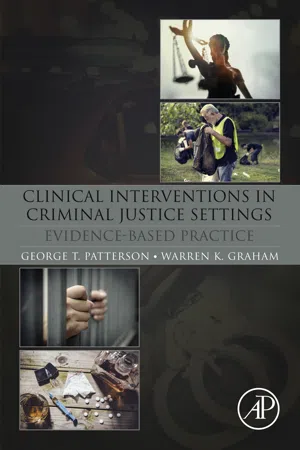
Clinical Interventions in Criminal Justice Settings
Evidence-Based Practice
- 220 pages
- English
- ePUB (mobile friendly)
- Available on iOS & Android
Clinical Interventions in Criminal Justice Settings
Evidence-Based Practice
About this book
Clinical Interventions in Criminal Justice Settings balances theoretical frameworks and research methodology to examine the effective evidence-based practices and principles for populations within the criminal justice system. The book explores the major clinical issues that are relevant for adopting evidence-based practices and demonstrates how to implement them. Topics include legislation, law enforcement, courts, corrections, actuarial assessment instruments, treatment fidelity, diverse populations, mental illness, substance use and juvenile delinquency.Clinical Interventions in Criminal Justice Settings models opportunities for evidence-based practice during entry into the criminal justice system (arrest), prosecution (court, pretrial release, jail, and prison), sentencing (community supervision, incarceration), and corrections (jail, prison, probation and parole).- Addresses offenders in all four components of the criminal justice system—legislation, law enforcement, courts and corrections- Covers the use of actuarial risk assessment instruments for clinical decision-making- Includes tools that predict recidivism, levels of service needed, and future offending behavior- Separates specific practices for juvenile and adult offenders- Delves into specific special populations, such as those with HIV and AIDS, substance abuse, co-occurring disorders and homelessness
Frequently asked questions
- Essential is ideal for learners and professionals who enjoy exploring a wide range of subjects. Access the Essential Library with 800,000+ trusted titles and best-sellers across business, personal growth, and the humanities. Includes unlimited reading time and Standard Read Aloud voice.
- Complete: Perfect for advanced learners and researchers needing full, unrestricted access. Unlock 1.4M+ books across hundreds of subjects, including academic and specialized titles. The Complete Plan also includes advanced features like Premium Read Aloud and Research Assistant.
Please note we cannot support devices running on iOS 13 and Android 7 or earlier. Learn more about using the app.
Information
Introduction to Evidence-Based Practices and Principles in the Criminal Justice System
Abstract
Keywords
Goals of the Book
The Criminal Justice System
The Adult Criminal Justice System
The Juvenile Justice System
Public Safety and Public Health
Table of contents
- Cover image
- Title page
- Table of Contents
- Copyright
- Preface
- Acknowledgments
- Chapter 1. Introduction to Evidence-Based Practices and Principles in the Criminal Justice System
- Chapter 2. Using Evidence to Inform Clinical Practice
- Chapter 3. An Overview of Implementation Fidelity
- Chapter 4. Clinical Outcomes for Criminal Justice Populations
- Chapter 5. The Evidence-Based Rating and Classification Process
- Chapter 6. Risk Assessment and Treatment Levels
- Chapter 7. Evidence-Based Practices for Juveniles in the Juvenile Justice System
- Chapter 8. Evidence-Based Practices for Adults in the Criminal Justice System
- Chapter 9. Evidence-Based Practice With Special Criminal Justice Populations
- Chapter 10. Implementing Evidence-Based Practices and Principles With Criminal Justice Populations
- Chapter 11. Criminal Justice Initiatives Using Evidence-Based Practices and Principles
- Appendix. Resources for Evidence-Based Criminal Justice Practice
- Index